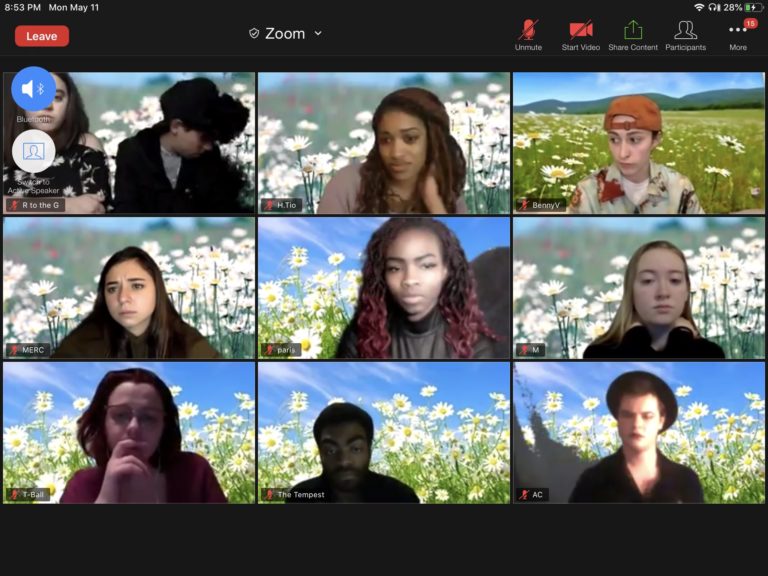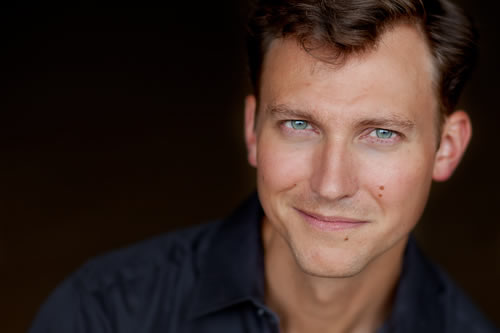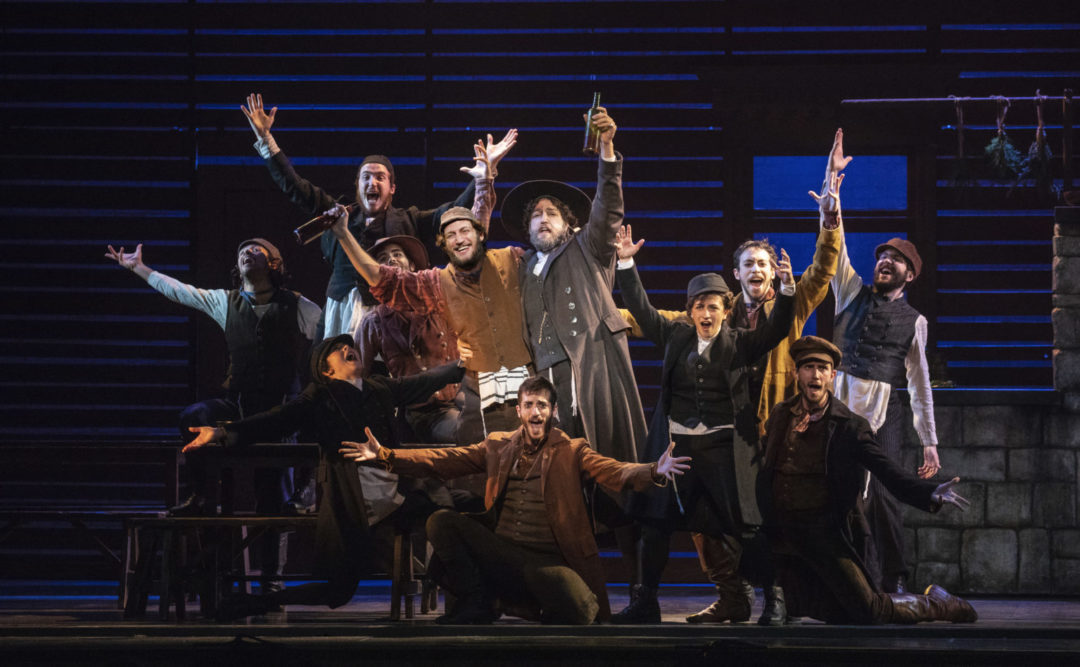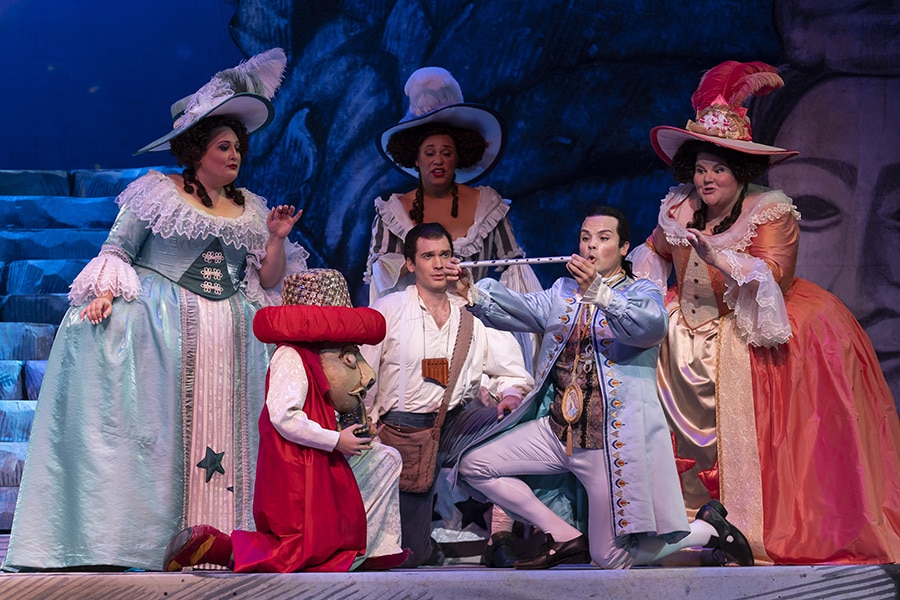By Daniella Ignacio
This article was first published April 8, 2020 in DC Theatre Scene here.
Zoom is a common mode of communication for the world affected by the COVID-19 pandemic. Schools and colleges use it for online classes; companies are using it for meetings; friends and family use it to stay in touch during a time of social distancing. For theatre companies, Zoom has proven to be an innovative tool to push forward the communal spirit of art in new ways, from online classes that go beyond the norm for theatre companies to livestreaming performances to the public. Here is just some of the interesting work that is being done by DMV theatre artists to maintain community and creativity.
Virtual Fitness at Synetic Theater
At Synetic Theater, Virtual Synetic Fitness classes are currently being offered over Zoom, which utilize Synetic physical theater techniques to give participants workouts. The class is taught by Synetic company member Alex Mills (he), who has been with the company since 2008.
“Because we are a physical theater, training has been an important part of our company since its birth,” education director Christopher Rushing (he) said. “We do training like three to four times a year with our company members, and then when we’re not doing training with our company members, we offer a fitness class where company members can attend for a reduced or free rate. But then we figured we’d also open it up to the community.”
Rushing said they initially looked into YouTube Live because of its accessibility, but decided on Zoom because of the ability to have both privacy and participation options, since it’s easy to pull up those who are using their own camera and participating, so Mills can give feedback.
“Obviously it’s different doing a fitness class online inherently because I’m by myself, I kind of get stimulated by having people in front of me, and you know, seeing the progress, how it’s going,” Mills said. “But using Zoom, I still actually feel like I’m with a class, because I can see people, I can still give technique notes or clarifications.”
Typically, when the class is run in person, it takes place in Synetic’s rehearsal studio, The Factory, where Mills would lead across the floor work that used the entire large space. Now that the class is online, tests are conducted for lighting, sound with a snowball mic and the company’s EpicCam HD camera 20 minutes before class. But besides not having the space, there actually is not a huge change in what can be taught, because “a lot of things that we do or that we do in training can be done, quote on quote, ‘in place,’ so to speak,” Mills said.
He also feels an extra layer of support, because people are actively like “I want to get up and move, you know, I want to do something,” he said. “It’s even more kind of that level of participation, it actually feels increased.”
Mills divides the class into four sections: cardio for about 15-20 minutes to keep participants’ heart rate going; stretching and technique work to slow it down, which is broken in various categories (isolation work, coordination exercises, pantomime, etc.); muscle work such as arms, shoulders or legs; and ending with a specific set of leg or core exercises. To explain movements, he demonstrates them from a few different angles, describes what muscle groups are activated and tries to put imagery in participants’ heads.“A lot of it is show and tell,” Mills said. “That’s the luxury of it being visual, is that I can go and do the movements with them, and then and say ‘Well, here’s what I need to correct, keep your head straight, lift your knees up, toes pointed,’ all those details. So I mean, it’s easy to communicate. Granted, I wish I was there to be able to give physical adjustments, to say isolate this or move this shoulder. But it’s still translating.”
Rushing has been taking the class and said he enjoys learning Synetic physical theater techniques. The first time Synetic tried out using Zoom for the class before opening it up to the public, it was after the indefinite postponement of Life Is A Dream, for which Mills served as movement director, and when people were practicing social distancing but it hadn’t been officially requested yet.
“Our company kind of all had gone home and they’d all been working with this common goal in mind and now that was gone,” Rushing said.
But with Synetic Fitness coming back, it gave the company a new way of coming together.
“It was cool to see how excited everyone was that it was coming back, and like, the energy, even though it was through virtual means, was like, palpable,” Rushing said. “It was really exciting and fun to be a part of. Even though I wasn’t teaching it, I was just producing it and making sure everything was running smoothly, it was still a really cool experience to see how excited everyone was and just how thankful people were to have that connection and that release again.”
It’s that kind of release that Mills believes can help artists maintain a sense of sanity during this time.
“We can get so stuck in our rooms, in our houses, and feeling like we can’t get anything done. I think just having that release, that physical release, is good for your own sanity, for real,” he said. “And feeling like you’re doing something — and a lot of us are, we’re still creating things, we’re still doing stuff — but physically doing something, moving our bodies, you know, makes it feel like, okay, I did that, I did that for an hour.”
Synetic offers a link to each class that’s available for a week afterwards for people who can’t attend it right at that time. It currently runs on a pay-what-you-can basis. Soon, Rushing said, Synetic will be expanding into school aged virtual options, during the school day as well as after school options. Synetic is currently working with Alexandria City Public Schools to deliver one of their family series shows as a streaming show.
This Vessel Is A Fragile Thing at 4615 Theatre
For 4615 Theatre, This Vessel Is A Fragile Thing by Britt A. Willis (they) was the company’s first foray into online readthroughs, by streaming a Zoom meeting to Facebook Live on March 23. The script has been around for some time, and during the first video call between 4615 Theatre resident artist Ezra Tozian (they) and Willis since the beginning of social isolation, Willis said, “Oh, it would be really cool to do a live reading of this and stream it, would you want to do it?”
Tozian had always been the first person Willis thought of to read for the role of The Body. This play’s messages spoke to Tozian.
“Being a nonbinary performer, person, human, whatever, and also going through the whole body positivity thing, well, how does one come to terms with their body?” they said. “And then like, what does one do when the idea of your body or what you’re promised is taken away or changed without your consent? I definitely got that from the play and it meant a lot.”
Tozian asked artistic director Jordan Friend (he) if 4615 could produce the show as part of the EP program which allows resident artists to pursue side projects. Friend’s response? “Absolutely, let’s do it.”
For Willis, this play was written in one week, but it was a hard piece to write and make feel complete. Though it is not autobiographical, the play reflects their feelings and relationship with bodies and chronic illness and their issues with the current body positivity culture.
“Often, I feel it still kind of puts the onus on people with bodies that are perceived as different or outside of the norm by our society,” they said. “It says you have to love yourself, and if you don’t, that’s a problem, when the truth is, it’s very hard to accept and love your body in every way possible, when that’s not how society functions, society hasn’t changed to do that as well and also I don’t always love my body, and that’s fine. It’s a body. And it’s okay that I don’t always love it. It’s a special play to me because it’s the first time that I very honestly engaged with those questions in my writing.”
Willis was the host for the Zoom meeting. Though they initially looked into the differences between Twitch and Zoom, they eventually decided on Zoom for its ease. According to Tozian, the cast all had at least basic experience with Zoom beforehand, so things like changing names were not hard to figure out.
The night before the readthrough, Willis did a practice run on their personal Facebook page. The cast rehearsed the same day as the readthrough, doing a runthrough with director Jon Jon Johnson, who gave notes on how to make it feel more like a live performance and how to draw focus using Zoom.
“One very cool thing that we couldn’t tell in the meeting is Jon Jon suggested people turn off their cameras when they weren’t in a scene, and on our meeting screen, the person would still be there but their box would be black,” Willis said. “But in the Facebook video, the way streaming works, it just drops the person.”
The result of this was that there would be long stretches where the Facebook livestream would just show certain actors performing and Willis saying the stage directions on screen, even though everyone was still on the call. At some points, it would be Tozian alone on screen. According to Friend, it was lovely to watch.
“It gives the feeling of someone being alone onstage, to have it just be our lead actor for a while and have sort of the company reappear,” he said. “It’s exciting because I think it lends a dynamic to the experience that can’t normally be there.”
For Tozian, this experience was a little bit like combining theatre and film acting together.
“I’ve been in the theatre long enough that I just speak loud all the time, so that’s why I have a hard time with a lot of film stuff,” they said. “I had to have my headset half out, just to make sure I wasn’t blowing out the mic or getting super fuzzy. Most of the time it was actually okay, it was kinda just like doing a readthrough, frankly, that’s kind of what it was, but every now and then reactions would take an extra second.”
It was also hard, Tozian said, because over Zoom, it was difficult to talk over each other or cut each other off, which happens frequently in this play, without it getting super fuzzy. That aspect of the script dynamic got kind of lost, they said. But with this group of actors who just made it work, it didn’t prove to be a problem.
They said that it still felt similar to performing live.
“To me, it felt the same as doing a live staged reading,” Tozian said. “So I thought that it was really fun, I had the same endorphin rush that I get after performing, it was great. It felt very normal, I guess.”
Willis has argued that Twitch is a form of theatre (“it can be affected by the audience, it is live, someone can mess up”), and having live functions similar to Twitch could make it a little closer to what they perceive as theatre. But they think this one worked incredibly well.
“I love that we did it live, I love that we didn’t try to turn it into something more film-like,” they said. “It’s not meant to be, it really can’t be, so I appreciate that we just committed to a reading. I think as a reading, it functioned really well. I got to hear a group of outstanding actors read this play, so it was absolutely great.”
Friend said that in the long run, 4615 is not doing this because the company thinks it equals live theatre; they’re doing it to give voice and support to D.C. playwrights.
“I don’t want us to pretend like we’re doing this instead of normal staged readings,” Friend said. “One of the things that we wanted to do was more work to help D.C. playwrights get their work displayed and trumpeted and workshopped. It’s so important for new plays to be heard out loud for the playwright and to raise awareness about these playwrights and their work. So I think the real benefit is there, not so much in 4615 creating content that substitutes live theatre because it just doesn’t.”
According to Friend, the company will probably do more play readings “to kind of keep the embers glowing, but mostly we’re in a phase of planning, just kind of figuring out what the next chunk of time is gonna look like,” he said.
On The Wings of a Mariposa at Adventure Theatre MTC
Similarly, at Adventure Theatre MTC, the company’s recent digital sneak peek presentation of next season’s On The Wings of a Mariposa by Alvaro Saar Rios also used a Zoom meeting that was streamed to Facebook. According to artistic director Chil Kong (he), the company was deciding between Bluejean and Zoom, and picked Zoom due to its ease of use.
“We’re trying to be creative and fun, doing some interesting innovative things,” Kong said. “We’re soon to be the first to really attempt distance rehearsals and we’re figuring out all of the technical strengths and weaknesses and how do you tell a story within this medium that you can’t really control? You know, we’re used to teching a show. So we’re learning a lot and we’re flying the plane while we’re building it.”
During the livestream, Kong had four screens operating at all times: Zoom itself, showing the actors’ faces; the chat box that was on his second screen; the Facebook live stream that he had an on iPad (because he “can’t be on the same system because it pulls so much energy and bandwidth to have it on the same system, it would literally crash everything,” Kong said); and a fourth screen with Instagram, which is connected to the ATMTC website, to check people’s comments.
“It’s not easy because what you see during Zoom isn’t necessarily what’s presented online,” Kong said. “Along with the marketing team, we’re all kind of tagging, checking each other so that if there are any glitches or faults, we are on it. And it’s not just one person, it’s like three of us who are on top of it, and I have one separate production stage manager who’s dealing with the Zoom itself. So it’s a lot of bandwidth, a lot of people power once we get it up.”
He’s been speaking with Silicon Valley consultants to figure it out, as well. “There are a lot of specifics within Zoom that you can learn, but I think what I have faith in is that the smart people who will learn how to use this, and not just Zoom, like any other platforms, is that you’ll learn the idiosyncrasies of each of them, and then figure out how to use that to help you tell your story,” he said.
Kong said that using Zoom with three young children from the ATMTC Academy and professional actors proved to be a lesson into how to connect without looking at someone’s eyes and learning what can be heightened using this platform, which proved to be acting that is more reliant on sounds because Zoom is sound-powered. For example, actors found that they needed to use gutturals before speaking in order for their videos to be highlighted on Zoom.
“The weird thing about the way this works, is that I have to connect with a dot, and so what’s happening is a lot of the the acting has to be about connected to something that doesn’t exist, and hope that the expressions that you’re presenting in your voice – so it became a lot of auditory responses as opposed to connecting visually one on one,” Kong said. “In a weird way it’s like watching a lot of people who don’t know how to connect.”
Kong connected this to his work with kids on the spectrum, who he said are amazing actors if they are told what the people are feeling; if you scripted it out for them, they can react in an interestingly natural way.
“It’s actually not that different for what we’re doing online; we’re scripting the emotions that are being presented to you and then you have to react to those things that are scripted, and not as much on the total visual,” he said. “So it’s a whole other style of acting.”
According to Kong, this is not a replacement for live theatre.
“At the end of the day, we will never be able to replace one-on-one human interaction, but we did want to at least tell the story so you can see it,” Kong said. “I think what was great was that everybody understood that this was a digital presentation, that this was a sneak peek into the theatre piece, and a great way to get excited about it, but it wasn’t the actual thing and our marketing team was really good about explaining that.”
For Kong, Zoom also exemplifies the beauty of one-on-one human interaction outside performance. He is on several leadership panels that deal with the API racism that is happening right now, and is in a group of artistic directors of color who are all new leaders in the DMV. Some other members of that group include Maria Manuela Goyanes from Woolly Mammoth and Raymond Caldwell from Theater Alliance, and they’ve been holding live panel conferences every week using Zoom to discuss how COVID-19 is affecting them and their work. They generally keep the topics loose, but they have that space to discuss and share with each other.
“We were the first one out of the gate to do a digital gala, so I talked about what we learned from that, and the only way that we can make things better is all of us talk to each other to figure out what’s working, what doesn’t work,” Kong said. “The dissemination of information is really, really exhilarating because of Zoom and these public panels in a way that hasn’t happened before.”
Before, he said, it used to be just people putting Facebook posts up and hoping for enough critical mass. But now it’s creating one-on-one connections that you can create on a conference call.
“You know, it’s weird, this is one step above the old days of ‘on the phone,’” he said. “And so you can see people’s interactions and though you can’t truly trust your gut instincts about what you feel on a video call, you have a closer connect than just a phone call.”
The future of Zoom and theatre: how long can theatre last like this?
According to several of these artists, for live streaming performances and staged readings, this form is something that needs to be assessed if it were to be used for an extended period of time.
“I think it would be a really different case if we were looking at converting our entire audience to a virtual audience,” Friend said. “In a way, it’s more akin to pop-up theatre in that it’s about “Where are the places where we can put something up where we know that people are already congregating?’”
Kong said that it will take certain people to truly make this platform work for them. “Here’s the thing, the innovators, the ones who figure this out, they’re the ones who are really gonna succeed beyond this, I think,” Kong said. “‘Cause they’ll figure out ways to generate revenue easier for themselves. But it’s really tough for us, in an art that is completely reliant on personal one-on-one interaction. So it is harder for us to make money this way, but there are ancillary ways to make money.”
But for people who are learning to take advantage of online options like Zoom and receive income from it, it can be the only way to receive income right now. That’s the case for Mills right now.
“That’s what’s hard right now, theatre artists in particular, is that we were doing stuff, or we should be doing something or working on something and we can’t,” Mills said. “And actually what I found is that this could be a totally viable option even when this whole thing is over. Just because I have people from New York taking the class, or people who couldn’t be here in person to do it, so I think it’s something that we could still offer once we’re back up and running.”
For many struggling artists right now, one staged reading is not enough to survive. As Friend said, it was the first time they did it (This Vessel Is A Fragile Thing) and people are not going to donate every time they do it.
“There’s a novelty to the process that gets everyone excited, but I think there’s a law of diminishing returns,” he said. “I don’t think this is a sustainable way for us to support our artists, I think we need to support our artists through emergency funds, and, you know, better unemployment laws. I think there are much bigger forces at play that need to happen for how we support our artists. I’m deeply grateful to everybody who gave, and deeply glad that we were able to compensate our artists, in a way that’s not insubstantial, but we’re not taking care of anybody’s rent on a staged reading, you know.”







